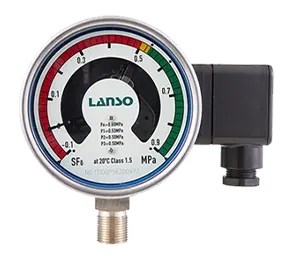Due to the excellent performance, safety, reliability, and convenient maintenance of SF6 circuit breakers, they have been widely used in power systems. As the main component of SF6 circuit breakers, SF6 relays are often only known by maintenance personnel as SF6 gas leak monitoring devices for timely control and protection of circuit breakers, with little knowledge of their daily maintenance. This article combines actual work to introduce the maintenance and verification of SF6 relays.
The basic technical parameter requirements of SF6 relays
Measurement range: -0.1/+0.5MPa; -0.1/+0.9MPa
Accuracy level: ambient temperature 20℃; 1.0 level, 1.6 level
Ambient temperature: -40℃~+60℃
Contact type: magnetic-assisted, micro switch
Protection level: IP65
The necessity of carrying out regular calibration of SF6 relays
The probability of gas leakage from circuit breakers themselves is very small, with an annual leakage rate of less than 1%. This does not have a significant impact on the density value of SF6 relays, so they are not frequently operated. As a result, the internal delicate mechanical parts may become less flexible or have poor contact, especially when the gas pressure, which changes with temperature, needs temperature compensation and cannot reliably operate. This can cause indication deviation errors and even erroneous movement of contacts, resulting in incorrect signals. Chinese industry standards "Preventive Testing Regulations for Electrical Equipment" and the power grid company's "Twenty-Five Key Requirements for Preventing Major Accidents in Power Production" also clearly stipulate that SF6 relays should be regularly calibrated to avoid indication errors or false operations caused by the relays themselves, which may affect the safety and stability of the power system.
Safety measures for calibrating SF6 relays
Calibration should be carried out when the circuit breaker is in the shutdown state;
Understand the arrangement of the circuit breaker's gas pipelines and know clearly which valves need to be switched during calibration;
For SF6 relays with self-check valves, they can be directly removed for calibration, and the self-check valves will automatically close without leakage;
The joint connecting the calibration instrument and the circuit breaker's pipeline should be matched to detect any leakage points to ensure the accuracy of calibration;
Alarms and lockout circuit operation tests should be conducted on SF6 relays;
If necessary, personnel should wear rubber gloves. In enclosed SF6 electrical equipment rooms, gas masks should be worn.
SF6 circuit breakers are widely used in power systems. Their reliable operation is also one of the important guarantees for stable power supply in power systems. SF6 relays are the only means installed on SF6 switches to monitor changes in SF6 gas density. Therefore, the performance of SF6 relays directly affects whether the circuit breaker can operate normally. Through regular inspection and calibration of SF6 relays, the SF6 medium of circuit breakers can maintain a good working condition for a long time.
Related Article for Reference
The Function and Principle of SF6 Gas Density Meter
1. The role of SF6 gas density meter and density relayThe so-called density refers to the mass per unit volume of a specific substance under specific conditions. The SF6 gas in the SF6 circuit breaker...
Mon 03 2021







